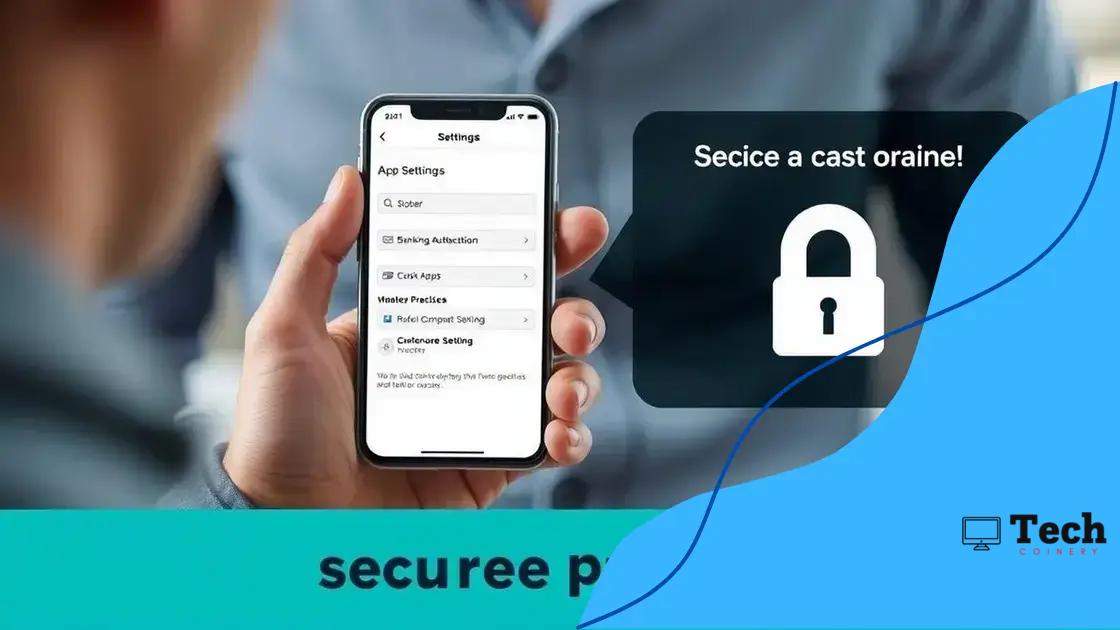Mobile banking fraud protections you need today

Mobile banking fraud protections include using strong passwords, enabling two-factor authentication, and promptly reporting suspicious activity to your bank to safeguard your financial information.
Mobile banking fraud protections are more important than ever as our reliance on digital financial transactions grows. Have you ever wondered how secure your mobile banking really is? Let’s dive into ways you can enhance your safety while banking on the go.
Understanding mobile banking fraud
Understanding mobile banking fraud is essential for anyone using digital banking services. As mobile banking becomes more popular, so does the risk of fraud. By learning about different fraud methods and how they occur, you can better protect yourself.
Types of Mobile Banking Fraud
Fraudsters use various techniques to deceive users. Some common types include:
- Phishing attacks that trick you into giving personal information.
- Malware that infects your device and steals your data.
- Account takeovers where scammers gain control of your account.
Being able to recognize these methods can help you stay vigilant. Scammers often leverage social engineering to manipulate victims into revealing sensitive information.
How Fraudsters Operate
Fraudsters may impersonate legitimate companies, sending emails or texts that appear to be from your bank. These messages often include links that lead to fake websites designed to capture your login credentials. It’s crucial to verify the sender before clicking any links.
Another tactic is to use fake notifications or alerts. If you receive a message about unusual activity, double-check with your bank directly rather than responding to the message. This kind of due diligence can protect you from falling victim to mobile banking fraud.
Understanding mobile banking fraud is not just about knowing the methods, but also being aware of suspicious signs. Regularly monitoring your account for unauthorized transactions is an effective way to safeguard yourself. Take proactive measures like enabling security notifications and using strong passwords.
Common types of mobile banking scams
Understanding common types of mobile banking scams can help you protect your finances. As we rely more on mobile banking, it’s crucial to be aware of the tactics used by scammers.
Phishing Scams
Phishing scams are popular among fraudsters. They often send emails or text messages that seem to come from your bank, asking you to verify your account. Always check the sender’s address before clicking any links.
- Look for spelling mistakes in the email.
- Verify the website’s URL before entering your information.
- Do not open attachments from untrusted sources.
If something looks off, it probably is. Report suspicious messages to your bank.
Malware Attacks
Another common scam involves malware. Fraudsters may trick you into downloading malicious apps that steal your information once installed. Always download apps from trusted sources like official app stores.
Keep your device updated with the latest security patches; this can reduce the risk of malware. Being cautious about the permissions you grant to apps is also crucial, as some may ask for access to sensitive data.
Common types of mobile banking scams can also include SIM swapping. In this case, scammers convince your mobile provider to transfer your number to a new SIM card controlled by them. This allows hackers to intercept your messages and access your accounts.
Protecting yourself from these scams requires vigilance and knowledge. Regularly monitor your bank statements for any unusual activity and report it immediately if you notice anything suspicious.
Essential protections to implement

Implementing essential protections is key to safeguarding your mobile banking experience. Knowing the right steps can make a big difference in keeping your accounts secure.
Strong Passwords
Using strong passwords is the first line of defense. A strong password should be unique and complex, combining letters, numbers, and special characters. Avoid using easily guessable information like birthdays or names.
- Change your passwords regularly.
- Use a different password for each account.
- Consider using a password manager to keep track of your passwords.
Strong passwords can significantly reduce the risk of unauthorized access to your accounts. Always make sure to log out after a banking session, especially on shared devices.
Two-Factor Authentication (2FA)
Another critical protection is two-factor authentication (2FA). This adds an extra layer of security by requiring two forms of identification before granting access to your account. Even if someone has your password, they cannot log in without the second factor.
Common methods of 2FA include receiving a code via SMS or using an authentication app. Enable this feature wherever possible to enhance your account security.
It’s also wise to keep your software up to date. Software updates often contain important security patches that protect your device from vulnerabilities. Enable automatic updates for your mobile applications and system software.
Regularly reviewing your account statements is crucial. Keep an eye on transactions to catch any unauthorized activity early. If you notice anything suspicious, report it to your bank immediately. By being proactive and informed, you can protect yourself from potential fraud.
How to recognize suspicious activity
Recognizing suspicious activity is vital for protecting your mobile banking. Being aware of the signs can help you act quickly and prevent potential fraud.
Unusual Transactions
One of the first indicators of suspicious activity is unusual transactions. This includes charges you don’t recognize or amounts that are larger than normal. If something doesn’t look right, investigate it immediately.
- Check your statement regularly for unexplained transactions.
- Set up alerts for transactions above a certain amount.
- Use your banking app to monitor transactions in real-time.
By taking these steps, you can catch fraudulent activity early.
Unexpected Account Notifications
Plausible notifications can also signify suspicious action. If you receive alerts about password changes or logins from unfamiliar devices, it’s essential to secure your account. Respond immediately to any warnings from your bank regarding your account activity.
Make sure to use secure contact methods to confirm any messages. Scammers can spoof notifications to trick you.
Unrecognized Devices
When you log into your mobile banking app, be aware of the devices connected to your account. If you see unfamiliar locations or devices, this could be a red flag. Most banking apps allow you to review active sessions.
Take the initiative to log out of any suspicious devices and change your password. Secure your account by enabling two-factor authentication, adding another layer of security to your access.
Ultimately, staying vigilant and informed about how to recognize suspicious activity can greatly reduce your risk of falling victim to mobile banking fraud. By monitoring your accounts and maintaining communication with your bank, you can help protect your financial information.
Steps to take if you fall victim
If you suspect that you have fallen victim to mobile banking fraud, it is crucial to act quickly. The sooner you take steps to address the situation, the better your chances of mitigating damage.
Contact Your Bank Immediately
Your first step should be to contact your bank. Inform them about the suspicious activity as soon as possible. They can help secure your account and start an investigation. Most banks have a dedicated fraud department that handles these issues.
- Use the customer service number provided on their official website.
- Report any unauthorized transactions that you notice.
- Follow any instructions they give you regarding securing your account.
Acting fast is key to protecting your funds.
Change Your Passwords
Changing your passwords is another important step. Update your bank account password immediately. Make sure the new password is strong and unique. This will help prevent further unauthorized access to your account. You should also change passwords for any other accounts that use the same or similar passwords.
Consider setting up two-factor authentication on your banking app if you haven’t done so already. This adds an extra layer of security.
Monitor Your Accounts
Keep a close eye on your bank statements and transaction history. Look for any unauthorized charges that may pop up after the fraud has been reported. Many banks offer alerts that notify you of any transactions over a specific amount. Sign up for these alerts to stay informed.
Staying vigilant can help detect further fraudulent transactions swiftly. If you notice anything unusual, report it immediately.
Consider a Credit Freeze
You may also want to consider a credit freeze. This will prevent new accounts from being opened in your name while you address the fraud. Contact one of the three major credit bureaus (Equifax, Experian, TransUnion) to initiate a credit freeze.
Taking these steps can help protect your financial health and limit the damage caused by mobile banking fraud.
FAQ – Frequently Asked Questions about Mobile Banking Fraud Protections
What should I do if I notice unauthorized transactions on my account?
Contact your bank immediately to report the unauthorized transactions. They can help secure your account and investigate the issue.
How can I protect my mobile banking app from potential fraud?
Use strong passwords, enable two-factor authentication, and regularly monitor your account for suspicious activity.
What is two-factor authentication and why is it important?
Two-factor authentication adds an extra layer of security by requiring a second form of verification, making it harder for fraudsters to access your account.
How can I recognize phishing attempts related to my bank?
Be cautious of emails or messages that ask for personal information or contain links to unfamiliar websites. Always verify the sender before clicking any links.






